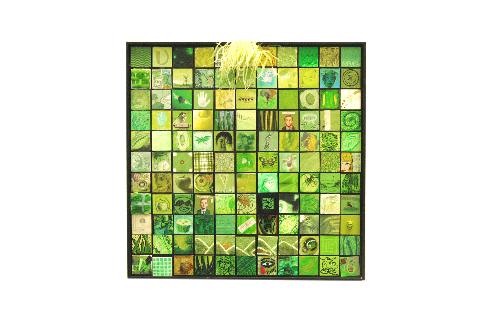“Ars longa, vita brevis,”—life is short, art long—runs the ancient proverb. Ask artist Peter Smuts, whose show “The Human Pixel Project” is currently showing at Mather’s Three Columns Gallery, and he might tell you that life is pixelated, and art even more so.
Smuts has assembled eight color-themed panels out of hundreds of two-inch square tiles. Each tile, however, is a work of art in its own right. Smuts started the project by sending out blank tiles to artists around the country, asking simply for something creative and specifying only that the tile have a dominant color.
Each of these tiles, when returned to Smuts, creates a pixel in his larger work.
“The project is spreading virally,” says Smuts, who started advertising for artists on Craigslist. “Just last week, I sent 800 tiles to Serbia.”
So far, Smuts is seeing a 60 percent return rate on the 1000 tiles he ships each week.
Smuts’s work inherently deals with the picture elements of everyday life, from the pixels of a computer screen to the square blocks of a city’s layout. Painting itself relies on pixelization in the suspended dots of insoluble pigment that give each color its hue. Indeed, the rods and cones of our eyes actually pixelize our view of reality, though with very fine resolution.
Artists have long turned to pixels as a medium, from the stunning Roman, Byzantine and early Christian mosaics (think of “Alexander at Issus,” or Ravanna’s splendid ceilings), to the Impressionistic dabs of paint employed by Monet and the Pointillism of Seurat and Signac. Chuck Close became famous for his large-scale portraits, using a grid of abstract pixels to create the larger picture.
Smuts’s monochromatic panels recall all this, and also consciously take a jab at the monochromatic paintings of the early minimalists. For Smuts, each tessera is important in its individuality, and its contrast to the whole.
The time and care taken by the artists of each tile is evident.
Yet, “I don’t entirely understand the appeal of the project,” admits Smuts. “Why would someone spend hours and hours on this work, and then send it to me?” Smuts’s artists must sign away all rights to their work; there is no financial compensation, and little recognition.
Smuts recounts an anecdote relating to one set of tiles he received from a Chicago comic-book artist that seemed to get at the driving feeling behind participation in the project. The package containing the tiles was covered in comic panels (themselves pixels of a larger work), and the artist had included a copy of one of his self-published comic books. The title of the book was “Proof That I Exist.”
“That sums it up, for me,” says Smuts. “It’s the creative instinct, to be part of a community, to be part of an idea.”
Erin A. Straw ’07 was one of the dozen or so Harvard affiliates who submitted tiles to the project. “I wanted to be part of it because it was such a really interesting idea,” she explains, echoing what Smuts felt.
The project is also inspirational, according to Mather House resident tutor Amber J. Musser ’02, who helps run the Three Columns Gallery. “It’s very inspiring, the beauty and detail of each pixel. I think it’s a testament to the potentials of human creativity,” says Musser.
Smuts plans to create representational mosaics, with each tile a pixel in a larger image, for future exhibits of the show. The impressionistic tiles created with pixelated daubs of color by Barbra Carter (of Wayland, MA) will themselves become simply a colored pixel in a mosaic.
With the strange and uncanny serendipity that sometimes inhabits the world of art, just a short walk from Mather is another example of pixel art. On the Weeks Footbridge, an anonymous artist has attached framed two-inch square pixels at intervals on the columned railing. This art is not as secure as the Latin proverb implies; some of the tiles have been pried off and taken away. One image that stands out is the form of a hot-air balloon rising above a city’s ethereal skyline. It is as if with each pixel, the anonymous artist firmly states: “this is proof that I exist.”
Read more in Arts
Portrait: Tom Conley













